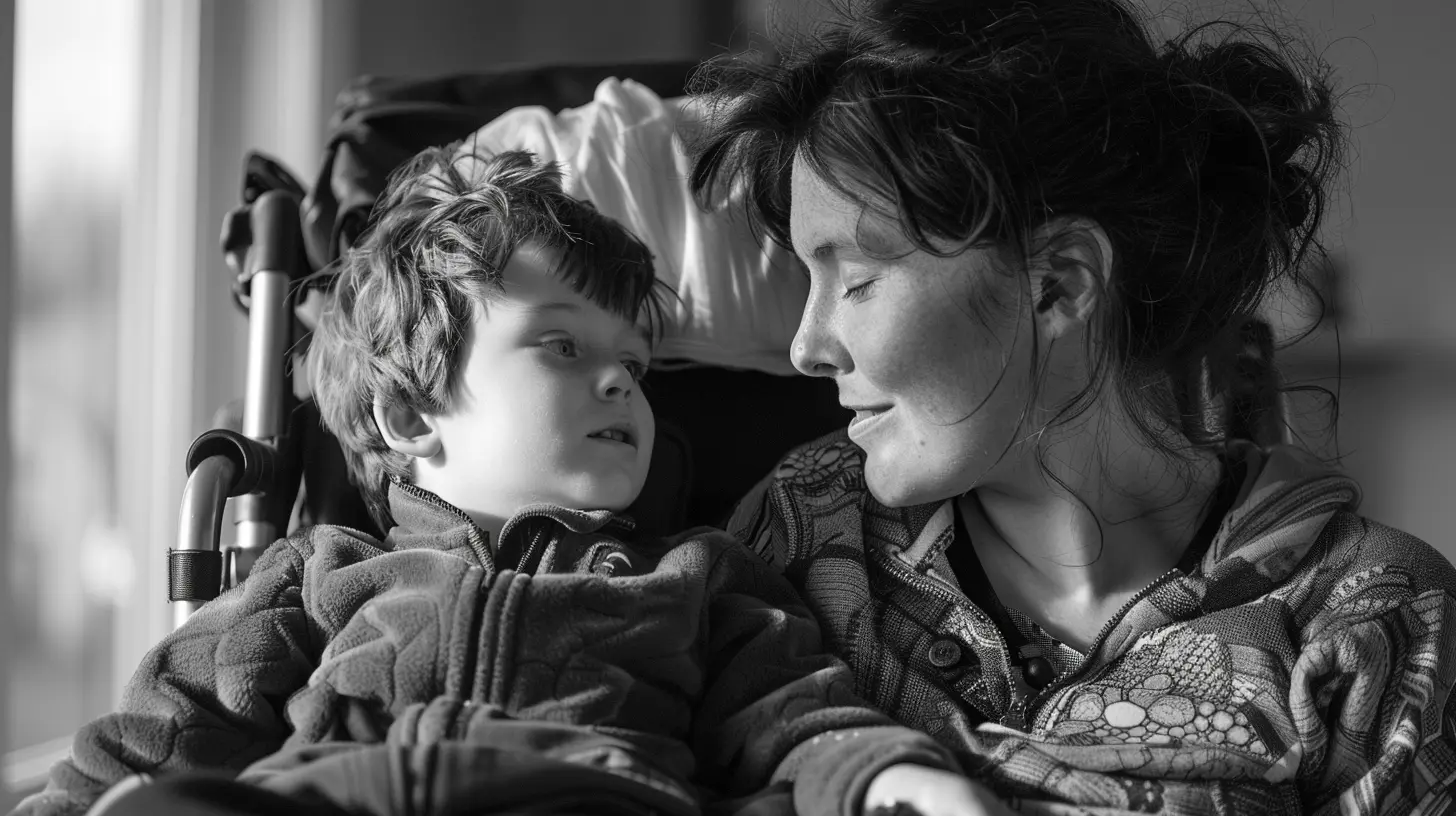Tackling the Sleep Struggles of Children with Special Needs
5 October 2025
Ah, sleep – that glorious, dreamy escape adults fantasize about while chugging coffee by 9 a.m. Now imagine adding special needs parenting into the mix. Yep, sleep becomes more like that mythical unicorn everyone talks about but no one has actually seen. If you’re nodding your head already, welcome to the club where coffee is a food group and bedtime routines take longer than the average Netflix binge.
Parents of children with special needs know that bedtime isn’t just “tuck in and lights out.” It’s a journey. A drama. A Broadway production where your kiddo is both star and stage manager. But before you collapse face-first into your couch, let’s walk (or crawl, no judgment) through the world of sleep issues and how we can tackle them one snore-less night at a time.

The Not-So-Secret Secret: Kids with Special Needs Often Struggle with Sleep
Let’s just throw it out there: sleep troubles are super common among children with special needs. You're not imagining things, and you’re definitely not alone.Whether your child has autism, ADHD, Down syndrome, sensory processing disorder, cerebral palsy, or another diagnosis, sleep can become as elusive as a toddler's ability to eat anything green. Studies show that anywhere from 50% to 80% of children with developmental or neurological differences have chronic sleep problems.
Why? Well, their brains just process the world differently – sights, sounds, emotions, even fatigue. So expecting them to fall asleep like their neurotypical peers is like expecting your cat to do your taxes. It ain’t happening without some creative intervention.

The Never-Ending Bedtime Battle: A Day in the Life
Let me paint you a picture (because misery loves company – and this one’s framed in crayon).It's 8 p.m. You’ve dimmed the lights, sung the lullaby, read “Goodnight Moon” three times, and whispered every calming affirmation you found on Pinterest.
And then?
“I need water.”
“I need to potty.”
“My sock feels weird.”
“There’s a sound in the wall.”
“Let’s talk about sharks.”
Sound familiar?
With neurodivergent kiddos, routine isn’t just important – it’s the difference between bedtime and a full-blown circus act. These kids thrive on predictability, and any little disruption (like a sock seam out of place) can trigger a spiral worthy of an Oscar.

Why Sleep Is So Darn Hard for Our Kids
Alright, time to dig into the why behind the yawns (and tantrums).1. Sensory Sensitivities
Some kids are like walking, talking sensory radars. The tiniest sound, itchy fabric, or flickering light can feel like a rock concert in their brains.If your child can detect light under the door like a CIA operative or insists their pajamas feel “scratchy” even after you’ve tried 17 different brands, sensory processing may be the culprit.
2. Irregular Melatonin Production
Melatonin is the sleepy hormone your brain releases when it's time to wind down. Children with special needs, especially those with autism, often have disrupted melatonin cycles. That means their internal clocks might be set to “party” when you’re hoping for “coma.”3. Anxiety and Overthinking
Kids with ADHD and anxiety disorders often struggle with racing thoughts at bedtime. Their brains are like that one friend who just won’t stop talking at 2 a.m. – “What if I forget my backpack?” “Do dogs dream?” “Was the moon always that bright?”4. Communication Barriers
Imagine feeling discomfort, but not being able to explain it. Frustrating, right? For non-verbal children or those with limited communication, they may be experiencing pain, fear, or unease and not be able to say what's wrong – leading to meltdowns or restlessness.
Let’s Talk Solutions (That Don’t Involve Duct Tape or Vodka)
Okay, okay, here’s why you’re really here. You want ideas. Real ones. Not “just have them count sheep” kind of ideas. Below are practical, sometimes funny, sometimes surprisingly effective tips and tricks fellow parents swear by.1. Create a Bedtime Routine – and Defend It Like a Jedi
Consistency is your BFF. It doesn’t have to be complicated – think bath, book, brush teeth, snuggles. But once you find a routine that works, protect it like your favorite hoodie from the laundry gremlins. Like clockwork, every night, even on weekends (yes, I know – ouch).Pro tip: Visual schedules! Use pictures to show each step of bedtime. These are magical for kids who thrive with visual cues.
2. Melatonin – Friend or Foe?
Before we go all in, always check with your pediatrician, okay? That said, melatonin supplements have been game changers for many families. It’s not a sleep drug – it just gives a nudge to that sleepytime signal. For some kids, it’s the difference between 2-hour bedtime battles and peaceful snoozing.3. The Sensory Sleep Setup
Let’s talk bedroom environments. Think of it like setting the stage for a Broadway nap.- Weighted blankets – Like a soothing hug, they help some kids calm their nervous system.
- White noise machines – Block out distracting sounds like the ice maker randomly exploding.
- Blackout curtains – Because sunlight at 6 a.m. shouldn’t ruin your child’s – or your – life.
- Essential oils (Lavender, baby!) – Aromatherapy may help set the stage for chill vibes.
Experiment! One child’s cocoon may be another’s nightmare. (I once bought a fancy sleep tent that became a rocket ship for late-night missions. Fail.)
4. Limit Stimulating Media Before Bed
YouTube Kids at 8:59 p.m.? Bad idea. Seriously bad idea. Blue light from screens messes with melatonin, and the content? Let’s just say watching ninja kittens or Minecraft replays doesn’t exactly say “let’s wind down.”Try switching it up with audiobooks or calming music. Some parents even swear by guided sleep meditations for kids – think of them as bedtime stories with a side of zen.
5. Address Medical or Behavioral Issues
Here's where professionals come in. If your child has sleep apnea, GI issues, seizures, or behavioral challenges, these can all impact sleep. Work with your pediatrician, OT, or behavior specialist to rule out or manage medical causes.Bonus: Pediatric sleep specialists exist! They’re like fairy godmothers for exhausted parents.
6. Bed Sharing – Yes? No? Maybe?
Listen, we’re not here to judge. If co-sleeping helps your child (and you) actually sleep, go for it. Just make it safe. And know that you’re not alone – co-sleeping is often a survival strategy for parents of children with special needs.But if you’re trying to transition your child into their own bed, take baby steps. Start small, maybe by sleeping in their room for a few nights, or using a transition object like a favorite stuffed animal that smells like you (not like week-old laundry).
7. Reward Systems: Bribe, But Make It Fashion
Sticker charts, bedtime bucks, “stay in bed” medals – whatever works. Kids love praise and silly incentives. Celebrate their sleep wins like they just won a gold medal in the Stay-In-Bed Olympics.“Hey, you stayed in bed all night? That’s three bedtime bucks toward a new Lego set!”
What If Nothing Works?
Take a breath. Or five.If you’ve tried every trick in the book (and even wrote your own sequel), it might be time to call in the cavalry. A pediatric sleep therapist or behavioral consultant can help customize strategies for your child’s unique needs.
And remember: This doesn’t mean you’ve failed. It means you’re human. And tired. And doing your best with a kid whose brain dances to its own beautiful rhythm.
A Pep Talk for the Tired Parent
You’re not crazy. You’re not overreacting. And you’re definitely not alone.You’re a parent of a superhero – one who just happens to be allergic to sleep. And while the road can be bumpy (and full of midnight snack requests), it’s also filled with moments of triumph, laughter, and those rare, magical nights when everyone sleeps through the night.
You’ll get there. One bedtime at a time.
And hey, let’s be honest – if you can survive toddler meltdowns, therapy appointments, IEP meetings, and three consecutive nights of no sleep, you can survive anything.
High five, sleep warrior. You’ve got this.
all images in this post were generated using AI tools
Category:
Special NeedsAuthor:

Steven McLain
Discussion
rate this article
1 comments
Lyra McCaw
In the moonlit hush, dreams often elude, Yet in gentle embraces, our love can imbue. Through whispered patience, we navigate the night, Guiding our children toward sleep's tender light.
October 8, 2025 at 2:47 PM

Steven McLain
Thank you for beautifully capturing the essence of love and patience in guiding children to sleep. It perfectly resonates with the challenges and hopes we experience in addressing sleep struggles.


